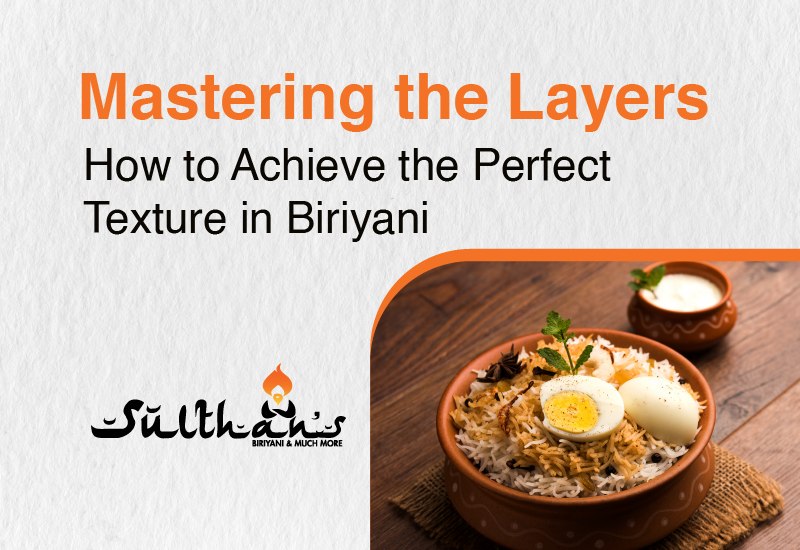Introduction
We go out on a gastronomic adventure and explore the core of biryani, where texture is king and turns every bite into a flavorful symphony. It is impossible to overestimate the importance of texture in this classic dish—it is the key to biryani’s attraction. The notion of creating the ideal biryani texture becomes alluring as we work to become experts at layering.
Tender meat, flavorful spices, and just-cooked rice come together to produce something more than just food. As we delve into the subtleties of biryani, we hope to improve not just the dish but the whole eating experience. So get ready to peel back the layers.
The Foundation – Choosing the Right Rice

The foundation of a great biryani is the meticulous choice of rice variety, which has a profound effect on both texture and flavour. Choosing aromatic rice types, such as long-grain or Basmati, is essential to maintaining the unique flavour and aroma of the grains.
Discover the art of steaming and parboiling rice—two crucial cooking methods that maintain the unique flavour of the grain while creating the perfect texture.
The rice’s capacity to absorb the tastes of the aromatic spices is further enhanced by soaking it before cooking, resulting in a cohesive and tasty basis for biryani. In this culinary adventure, mastering the subtleties of rice becomes essential to obtain the ideal texture in each delicious bite.
Layering Flavors – Marination Techniques
Meat and vegetable flavours are enhanced by the culinary practice of marinating. It’s a skilful way to guarantee succulence and infuse tastes. Starting with a tasty foundation such as onions, ginger, or garlic can help you establish the ideal mix of aromatics and spices.
For softness, mix them with acids such as vinegar, lemon juice, or yoghurt. Next, choose a well-balanced combination of herbs and spices, taking into account the type of food you want to prepare—Mediterranean, Asian, or Latin, for instance.
Let the flavours develop over time; marinating overnight is really effective. Enclose your contents in a ziplock bag or an airtight container to enhance contact and absorption. Remember to add just the right amount of salt to improve the flavour.
It’s important to experiment and personalise the amounts. You can transform ordinary items into culinary marvels and wow your taste with a symphony of flavours and sensations by perfecting the art of marinating.
Crafting the Aromatic Base – Onions, Tomatoes, and Spices

In many cuisines, sautéing onions, tomatoes, and spices is an essential first step. Heat oil in a pan over medium heat to begin creating an aromatic base. Add the finely chopped onions and sauté until they release their fragrant scent and become transparent. The onions become caramelised throughout this process, giving the meal more flavour and sweetness.
Add the minced ginger and garlic, along with a mixture of spices, including paprika, coriander, and cumin. The tastes of the spices are enhanced when they are quickly toasted in the heated oil, which releases their essential oils. Add the chopped tomatoes last, letting them soften and combine with the spices to create a base of flavour that is rich and aromatic and lifts the whole meal.
The Protein Layer – Cooking Meat to Perfection
Take into account a variety of cooking techniques to produce meat that is tasty and soft, and that blends well with rice and other ingredients. Before grilling or searing, beef can benefit from marinating in a mixture of acids (such as vinegar or citrus), herbs, and spices to improve softness and taste. Brine or slow-roast chicken with aromatics to guarantee flavour and moisture.
Tenderness may be achieved in pork by braising in a sauce or slow cooking in a flavoured broth. Plus, sous-vide cooking yields tender meat and allows for exact temperature control. Harmony is further enhanced when the cooked meat is paired with complementing flavours and sauces, such as teriyaki for rice.
Introducing Moisture – Yogurt and Other Liquids
A delicious and luscious texture is achieved by adding more moisture to the biryani with the use of yoghurt and other liquids. Because of its creamy texture, yoghurt gives the meal a nice tang and tenderises the meat or veggies. It also creates a protective covering that keeps the rice from drying out too much while it cooks.
The rice absorbs other liquids, such as broth or water, and becomes plump and tasty grains. These components work in concert to produce a pleasing equilibrium of moisture, which keeps the biryani from drying out and improves its flavour and texture overall.
Perfecting the Rice-Meat Ratio
The entire texture and flavour of the dish are greatly influenced by the balance. A meal that is overly heavy on meat can be created by overpowering the subtle flavours of the fragrant rice and spices. On the other hand, a biryani with insufficient meat may taste boring or uninteresting.
Although there is no set optimal ratio, it is commonly advised to use a ratio of 1:1.5 to 1:2 for rice to meat. This keeps the meat from imparting its rich, savoury flavour while the rice keeps its fluff and fragrance. A satisfying and pleasurable biryani experience is guaranteed when the proper balance is found.
The Crucial Dum Cooking Technique

A centuries-old culinary method called “dum cooking” involves slowly cooking food beneath a tight-fitting cover in order to generate remarkable flavour fusion and texture. This technique produces a regulated atmosphere where components simmer softly and blend together thanks to the steam trapped within the pot.
A balanced and enhanced flavour profile is produced by the sealed cover, which keeps out moisture and scent. Tough chunks of meat are tenderised, fragrant spices are infused, and the tastes are allowed to mingle harmoniously. As a result, the dish has a melt-in-your-mouth texture and rich, nuanced tastes that are widely loved. This makes dum cooking an artistic culinary legacy.
Garnishes and Finishing Touches
A key component of improving the biryani’s sensory experience is the garnish. Fresh herbs like mint and cilantro provide lively aromas and a cooling scent, while fried onions provide a delicious crunch to balance the soft rice and meat. Nuts, such as cashews or slivered almonds, add a mild, creamy texture and a delicious nuttiness.
In addition to adding texture and flavour, these garnishes offer a pop of colour that contrasts with the dish’s rich, golden tones to create a visually appealing contrast. When combined, they elevate a basic biryani to a visually captivating, multifaceted culinary masterpiece that satisfies the tongue and the sight, satisfying every sense.
Sulthans Biryani

Sultan’s Biryani is a gastronomic treasure, with each bite touching the soul via a special combination that goes beyond the senses. Their aromatic long-grain basmati rice is expertly piled with marinated meat and a special blend of spices to create their biryani, a culinary masterpiece. An unmatched dining experience is provided by the luscious, supple meat that has been combined with the fragrant enchantment of Sultan’s trademark mix.
Every taste is a symphony of flavours and sensations that create a lasting memory. Sultan’s Biryani is a monument to the skill of biryani-making, where each spice and grain of rice work in perfect harmony to produce a mouthwatering dish.
Bottomline
In order to have the ideal texture in biryani, it takes careful preparation, with each layer being very important. The first layer is composed of well-cooked rice, which is separate and fluffy yet maintains its structure.
The second layer is made up of marinated meat or veggies, which provide taste and succulence. Next, a fragrant base is created with sautéed onions and aromatic spices. Yoghurt, herbs, and garnishes continue the stacking, adding to the dish’s complexity.
Lastly, the layers are sealed and given time to combine using the dum cooking process, giving the biryani an unmatched depth of flavour. Gaining mastery over these levels enables you to produce a delicious biryani, which is a culinary adventure worth taking on with renewed competence and self-assurance.
FAQs
- What makes a perfect biryani?
Aromatic spices, caramelised onions, and well-marinated beef are placed atop fragrant, long-grain basmati rice to create the ultimate biryani. It is crucial to get the ideal taste balance, soft meat and cooked rice. The food should smell like a well-balanced spice mix and have a delicious aftertaste.
- What is the secret ingredient in biryani?
A fragrant spice mix is the fundamental element in biryani, and quality is of the utmost importance. The meal is enhanced with fresh herbs, saffron, and garam masala. But the real magic is in the skill and love of the cook and how they blend the flavours so precisely that each mouthful has the ideal balance.
- How would you describe a good biryani?
The tastes and textures of an excellent biryani blend harmoniously. Succulent meat, fragrant spices, and fragrant basmati rice combine to make a flavorful combination. It is a gastronomic feast with delicate beef, properly cooked rice and a subtle spice that lingers with every bite.
- Which biryani style is best?
Whatever is considered “best” for biryani is a matter of taste and personal choice. Lucknawi biryani is recognised for its delicate and fragrant flavour, whereas Hyderabadi biryani is recognised for its spicy and aromatic characteristics. In the end, the cooking style that most suits a person’s personal tastes is the greatest.




